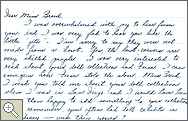|
|
 |
 |
 |
|
Lesson Plan |
|
Introduction
-
Step One
-
Step Two
-
Step Three
-
Step Four
-
History:Whose Story
|
 |
 |
 |

History as Histories
In this lesson, students make deductions about life in an internment camp by reading and comparing letters written to Clara Breed. Along the way, they consider the advantages of looking at a historical event from the multiple points of view of eyewitnesses.
The Japanese American internment serves as a good example of the prismatic nature of history. In all, some 120,000 people lived in the camps. There were, then, some 120,000 different versions of the internment experience.
There are special challenges in the study of letters as primary sources. Unlike most diaries, a letter is intended for another reader. The historian must consider, as your students will, the motivations and purposes of the writer, and the relationship between writer and reader.
The letters printed here were edited for length; misspellings were emended when they might have obscured the writer's meaning. We encourage you to read the collection of letters on the Web site of the Japanese American National Museum, where you will find the complete Miss Breed collection. You might choose to substitute letters or portions of letters that would better suit the reading level of your class.
The museum also offers an award-winning thirteen-minute video, Dear Miss Breed, which comes with an extensive teacher's guide. Ordering information is at www.store.yahoo.com/janm.
Materials
Printouts:
|
 |
 |
 |
 |

Read a letter written to Miss Breed
|
 |
 |
 |
|


|
|
|

